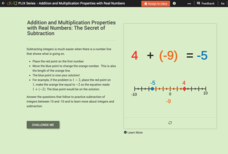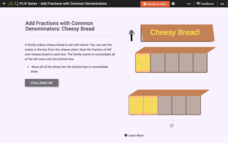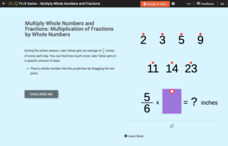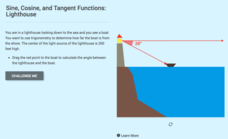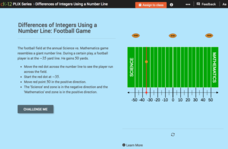Curated OER
Adding 10
A total of 50 basic addition problems are contained with in this worksheet. Your class can hone their math skills by adding 10 to a variety of numbers. Tip: When they are done have them discuss and identify any patterns they can find.
Curated OER
Add Three Numbers - Leveled Problem Solving
There are many ways to add. Learners add 3 single digit number together to find an answer to each of the 6 word problems. A great worksheet that builds problem solving and basic addition skills.
Curated OER
The Great Mezmo
Students play an easy card game that reinforces skill such as: basic number recognition, greater than or less than, and odd or even number.
Curated OER
Teaching Students Mathematical Reasoning Skills
Students can build upon their basic math skills and become higher order thinkers when we encourage the following principles.
Curated OER
Basic Skills: Lines, Segments and Rays
In this basic skills instructional activity, students draw lines, segments, and rays according to given instructions. This four-page instructional activity contains 20 problems. Answers are provided on the last two pages.
Curated OER
Quilt Squared
Students study West Virginia quilts. In this mathematics lesson, students use symmetry, geometric shapes, and patterns to create their own quilt square.
Captain Planet Foundation
Square Foot Fall Garden
First graders learn the basic needs of plants and identify geometric shapes while planting a fall garden. Combining math and science in one lesson, the resource guides kids through starting their class garden as they discover the...
Curated OER
Mapmaker, Mapmaker, Make Me a Map
Second and third graders practice with basic map skills. They create their own map including a legend and a compass rose. This fabulous plan has many excellent websites linked which allow learners to explore maps of all kinds; including...
Curated OER
Math Circuit
Students develop fitness levels and reinforce specific sports skills while integrating basic math.
Curated OER
Cuisenaire Rods And Math
Learners find the least common multiple of several given numbers using Cuisenaire rods. Previously taught math skills are reinforced by using Cuisenaire rod games, puzzles and or activities.
Lane Community College
Review Sheets: Introductory Physical Science
This hybrid worksheet connects mathematics to a science class. Learners practice solving problems that involve making a variety of conversions. An assortment of questions hits all the calculations needed for a middle school or beginning...
Learner
Solid Shapes
A collection of two lessons, kindergartners will identify two-dimensional shapes in solid shapes. They will develop basic knowledge of the components that make up a sphere, rectangular prism, pyramid, cylinder, cone, and cube. Young...
Diablo Valley College
The Language of Sets and Set Notation
The basics of number theory and set notation are explained in a highly approachable way in a self-contained lesson and worksheet. Introducing the vocabulary and concepts from ground zero and building to more complex ideas of subsets and...
CK-12 Foundation
Addition and Multiplication Properties with Real Numbers: The Secret of Subtraction
An interactive boosts mathematicians' knowledge of subtracting integers using a horizontal number line by way of multiple-choice, true or false, and discussion questions.
CK-12 Foundation
Sums of Fractions with Like Denominators: Cheesy Bread
Five questions make up an interactive all about adding fractions with like denominators. Mathematicians answer multiple-choice problems and an open-ended question using a fraction model that resembles sliced bread. The practice ends with...
CK-12 Foundation
Area and Volume of Similar Solids: Similar Solids
Five questions make up an interactive designed to boosts knowledge of area and volume of solid figures. Question types include multiple-choice, true or false, and fill-in-the-blank. A scale model changes measurement to provide a visual...
CK-12 Foundation
Large Decimal Rounding to Decimal Representations: Weighing a Whale
An interactive challenges mathematicians to round large numbers with help from a large scale that measures the weight of a blue whale. The practie's five questions include multiple-choice, fill-in-the-blank, true or false, and an open...
CK-12 Foundation
Displaying Univariate Data: Ordering Leaves
Leaf a little time to organize data. Given data displayed in a stem-and-leaf plot, learners organize the data in a list. Pupils use the data to determine the mode, median, and range of the data set. They determine the benefits of using a...
CK-12 Foundation
Multiplication of Whole Numbers by Fractions: Multiplication of Fractions by Whole Numbers
An interactive challenges mathematicians to multiply fractions by whole numbers. A model provides a clear visual aid in preparing whole numbers to be multiplied. Six questions include multiple-choice, fill in the blank, short answer, and...
EngageNY
Three-Dimensional Space
How do 2-D properties relate in 3-D? Lead the class in a discussion on how to draw and see relationships of lines and planes in three dimensions. The ability to see these relationships is critical to the further study of volume and other...
CK-12 Foundation
Sine, Cosine, and Tangent Functions: Lighthouse
How far is that boat from the lighthouse? Scholars create diagrams to represent a scenario given the angle of depreciation from a lighthouse to a boat. Learners apply the basic trigonometric functions to find various distances stemming...
CK-12 Foundation
Differences of Integers Using a Number Line: Football Game
Make football a math sport! Move the football player (red dot) along the sideline (number line) to see how many yards (positive and negative integers) they've traveled to the other team's end zone.
CK-12 Foundation
Law of Cosines: Get on Base
Baseball is all about math. Young baseball and mathematics enthusiasts determine the distance between players on a baseball field using the Law of Cosines. An interactive helps them find relevant distances and angles to use in their...
CK-12 Foundation
Measurement of Probability
Stockings make your legs warmer and math more enjoyable. A drag-and-drop interactive has pupils take stockings out of drawers to calculate probabilities. This includes dependent events where the probabilities depend on previous stocking...















